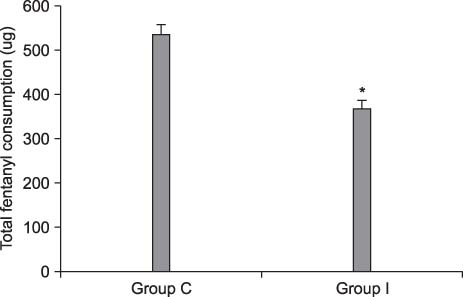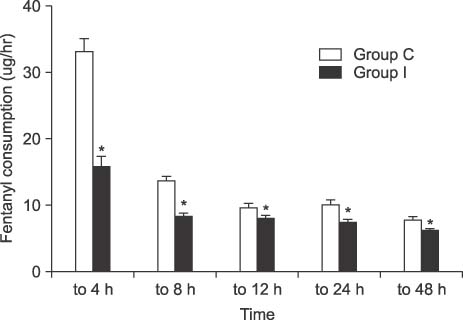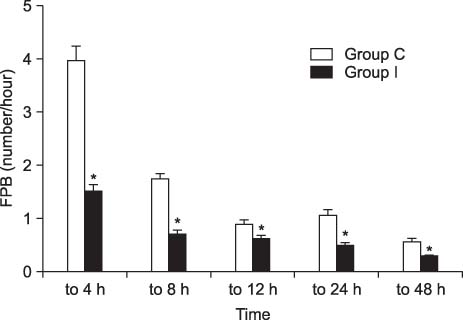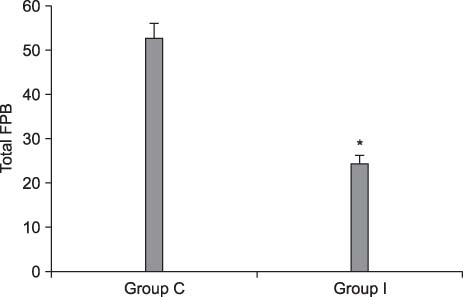J Korean Surg Soc.
2010 Aug;79(2):130-136. 10.4174/jkss.2010.79.2.130.
Intraperitoneal Ropivacaine Instillation for Postoperative Pain Relief after Laparoscopic Cholecystectomy
- Affiliations
-
- 1Department of Surgery, College of Medicine, Chung-Ang University, Seoul, Korea.
- 2Department of Anesthesiology and Pain Medicine, College of Medicine, Chung-Ang University, Seoul, Korea. roman00@naver.com
- 3Department of Surgery, Kyungpook National University Hospital, School of Medicine, Kyungpook National University, Daegu, Korea.
- KMID: 2211983
- DOI: http://doi.org/10.4174/jkss.2010.79.2.130
Abstract
- PURPOSE
A study was designed to assess the effect of intraperitoneal instillation of ropivacaine in larparoscopic cholecystectomy patients using computerized patient controlled anesthesia (PCA).
METHODS
From January 2009 to June 2009, 40 patients with uncomplicated, symptomatic cholecystitis with cholelithiasis who were referred to Chung-Ang University Medical Center for laparoscopic cholecystectomy were included in the study. Patients in group C (control group) received normal saline 100 ml and those in group I (instillation group) received intraperitoneal instillation of 2 mg/kg of ropivacaine diluted in 100 ml saline at the initiation of pneumoperitoneum. Patients were assessed for pain by blinded investigators at 6 time intervals after surgery; 2 hr, 4 hr, 8 hr, 12 hr, 24 hr, and 48 hr. The frequency at which patients pushed the button of the PCA on bolus requirement (FPB) was assessed by a patient-controlled module on the PCA machine.
RESULTS
The mean total fentanyl consumption was lower in group I (367.39+/-85.88) than in group C (535+/-100.29) during the 48 hours (P<0.001). Fentanyl velocity and FPB showed significant difference between the groups (P<0.005). Visual analogue scale (VAS) measured pain scores were significantly lower in group I than in group C at 4 hr (P=0.027), 8 hr (P=0.010), 12 hr (P=0.011).
CONCLUSION
Intraperitoneal instillation of ropivacaine at the beginning of laparoscopic cholecystectomy (LC) combined with normal saline infusion is an effective method for reducing pain after LC.
MeSH Terms
Figure
Reference
-
1. Schirmer BD, Edge SB, Dix J, Hyser MJ, Hanks JB, Jones RS. Laparoscopic cholecystectomy. Treatment of choice for symptomatic cholelithiasis. Ann Surg. 1991. 213:665–676.2. Tsimoyiannis EC, Siakas P, Tassis A, Lekkas ET, Tzourou H, Kambili M. Intraperitoneal normal saline infusion for postoperative pain after laparoscopic cholecystectomy. World J Surg. 1998. 22:824–828.3. Bisgaard T, Kehlet H, Rosenberg J. Pain and convalescence after laparoscopic cholecystectomy. Eur J Surg. 2001. 167:84–96.4. Mouton WG, Bessell JR, Otten KT, Maddern GJ. Pain after laparoscopy. Surg Endosc. 1999. 13:445–448.5. Karaaslan D, Sivaci RG, Akbulut G, Dilek ON. Preemptive analgesia in laparoscopic cholecystectomy: a randomized controlled study. Pain Pract. 2006. 6:237–241.6. McLauchlan GJ, Macintyre IM. Return to work after laparoscopic cholecystectomy. Br J Surg. 1995. 82:239–241.7. Barczynski M, Konturek A, Herman RM. Superiority of preemptive analgesia with intraperitoneal instillation of bupivacaine before rather than after the creation of pneumoperitoneum for laparoscopic cholecystectomy: a randomized, double-blind, placebo-controlled study. Surg Endosc. 2006. 20:1088–1093.8. Wills VL, Hunt DR. Pain after laparoscopic cholecystectomy. Br J Surg. 2000. 87:273–284.9. Verma GR, Lyngdoh TS, Kaman L, Bala I. Placement of 0.5% bupivacaine-soaked Surgicel in the gallbladder bed is effective for pain after laparoscopic cholecystectomy. Surg Endosc. 2006. 20:1560–1564.10. Pappas-Gogos G, Tsimogiannis KE, Zikos N, Nikas K, Manataki A, Tsimoyiannis EC. Preincisional and intraperitoneal ropivacaine plus normal saline infusion for postoperative pain relief after laparoscopic cholecystectomy: a randomized double-blind controlled trial. Surg Endosc. 2008. 22:2036–2045.11. Adams WJ, Avramovic J, Barraclough BH. Wound infiltration with 0.25% bupivacaine not effective for postoperative analgesia after cholecystectomy. Aust N Z J Surg. 1991. 61:626–630.12. Lepner U, Goroshina J, Samarutel J. Postoperative pain relief after laparoscopic cholecystectomy: a randomised prospective double-blind clinical trial. Scand J Surg. 2003. 92:121–124.13. Helvacioglu A, Weis R. Operative laparoscopy and postoperative pain relief. Fertil Steril. 1992. 57:548–552.14. Gupta A, Thorn SE, Axelsson K, Larsson LG, Agren G, Holmstrom B, et al. Postoperative pain relief using intermittent injections of 0.5% ropivacaine through a catheter after laparoscopic cholecystectomy. Anesth Analg. 2002. 95:450–456.15. Joris J, Thiry E, Paris P, Weerts J, Lamy M. Pain after laparoscopic cholecystectomy: characteristics and effect of intraperitoneal bupivacaine. Anesth Analg. 1995. 81:379–384.16. Bisgaard T, Klarskov B, Kristiansen VB, Callesen T, Schulze S, Kehlet H, et al. Multi-regional local anesthetic infiltration during laparoscopic cholecystectomy in patients receiving prophylactic multi-modal analgesia: a randomized, double-blinded, placebo-controlled study. Anesth Analg. 1999. 89:1017–1024.17. Ure BM, Troidl H, Spangenberger W, Dietrich A, Lefering R, Neugebauer E. Pain after laparoscopic cholecystectomy. Intensity and localization of pain and analysis of predictors in preoperative symptoms and intraoperative events. Surg Endosc. 1994. 8:90–96.18. Papadima A, Lagoudianakis EE, Antonakis P, Filis K, Makri I, Markogiannakis H, et al. Repeated intraperitoneal instillation of levobupivacaine for the management of pain after laparoscopic cholecystectomy. Surgery. 2009. 146:475–482.19. Kehlet H, Gray AW, Bonnet F, Camu F, Fischer HB, McCloy RF, et al. A procedure-specific systematic review and consensus recommendations for postoperative analgesia following laparoscopic cholecystectomy. Surg Endosc. 2005. 19:1396–1415.20. Boddy AP, Mehta S, Rhodes M. The effect of intraperitoneal local anesthesia in laparoscopic cholecystectomy: a systematic review and meta-analysis. Anesth Analg. 2006. 103:682–688.21. Labaille T, Mazoit JX, Paqueron X, Franco D, Benhamou D. The clinical efficacy and pharmacokinetics of intraperitoneal ropivacaine for laparoscopic cholecystectomy. Anesth Analg. 2002. 94:100–105.22. Knudsen K, Beckman Suurkula M, Blomberg S, Sjovall J, Edvardsson N. Central nervous and cardiovascular effects of i.v. infusions of ropivacaine, bupivacaine and placebo in volunteers. Br J Anaesth. 1997. 78:507–514.
- Full Text Links
- Actions
-
Cited
- CITED
-
- Close
- Share
- Similar articles
-
- Intraperitoneal nebulization versus intraperitoneal instillation of ropivacaine for postoperative pain management following laparoscopic donor nephrectomy
- The Effects of Intraperitoneal Local Anesthetics on the Postoperative Pain Relief in Laparoscopic Cholecystectomy
- Effects of Intraperitoneal Lidocaine on Abdominal and Shoulder Pain after a Laparoscopic Cholecystectomy
- The Effect of Intraperitoneal Instillation and Trocar Site Infiltration of 0.25% Levobupivacaine on the Postoperative Pain after Performing Laparoscopic Cholecystectomy under Remifentanil Based Anesthesia
- The Effect of 0.5% Bupivacaine Instillation for the Postoperative Pain after Laparoscopic Cholecystectomy






